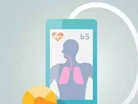[INFOGRAPHIC] The Complicated, Evolving World of mHealth

The world is undoubtedly becoming more connected, but there’s one place that the 21st century wave of connectivity has yet to conquer: the human body.
That could all be changing soon though. As technology is becoming cheaper and relatively easier to improve upon, developers are looking at existing tech and trying to apply it in new ways. This is where electronic health, or eHealth, enters the mix.
EHealth is a complicated topic as it tends to encompass everything that walks the line between the electronics and healthcare industries.
In search of a better definition for the sector, the editorial team at JMIR Publications defined eHealth as, “… an emerging field in the intersection of medical informatics, public health and business, referring to health services and information delivered or enhanced through the Internet and related technologies. In a broader sense, the term characterizes not only a technical development, but also a state-of-mind, a way of thinking, an attitude and a commitment for networked, global thinking, to improve health care locally, regionally and worldwide by using information and communications technology.”
In essence, eHealth pertains to a vast array of technologies and developments in the medical sector in the last decade or two and the definition tends to shift in each context.
But subsectors of eHealth have arisen that offer a bit more clarity. One such sector is mobile health, or mHealth, which utilizes mobile devices like tablets, but predominantly smart phones, to allow better connectivity between consumers, medical providers and business, while allowing for greater monitoring of patient conditions.
One example of mHealth is telemedicine, which has seen explosive growth in the last few years. While serious patient symptoms must still be reviewed in-person by a qualified medical professional, routine check-ups in non-emergency scenarios are still increasingly being done using remote platforms, such as Skype or many other more specialized programs.
On the more cutting-edge end of the sector are real-time monitoring devices, which allow medical professionals and family members of a patient to receive real-time notifications if there is a significant change in vital signs.
The field is still an emerging one that is sure to change drastically in the immediate future, but to help clarify this complicated topic, the folks at Pathfinder Software created the following infographic.

To see more news and insight from the world of medicine, like us on Facebook and follow us on Twitter.
- Fujitsu and Nvidia: Harnessing AI to Transform HealthcareTechnology & AI
- Johnson & Johnson: Transforming Medicine with NLPMedical Devices & Pharma
- Vaccines, Dementia & Food: The Week's Top Healthcare StoriesMedical Devices & Pharma
- Stanford: A Shingles Vaccine Could Cut Dementia Risk by 20%Medical Devices & Pharma



